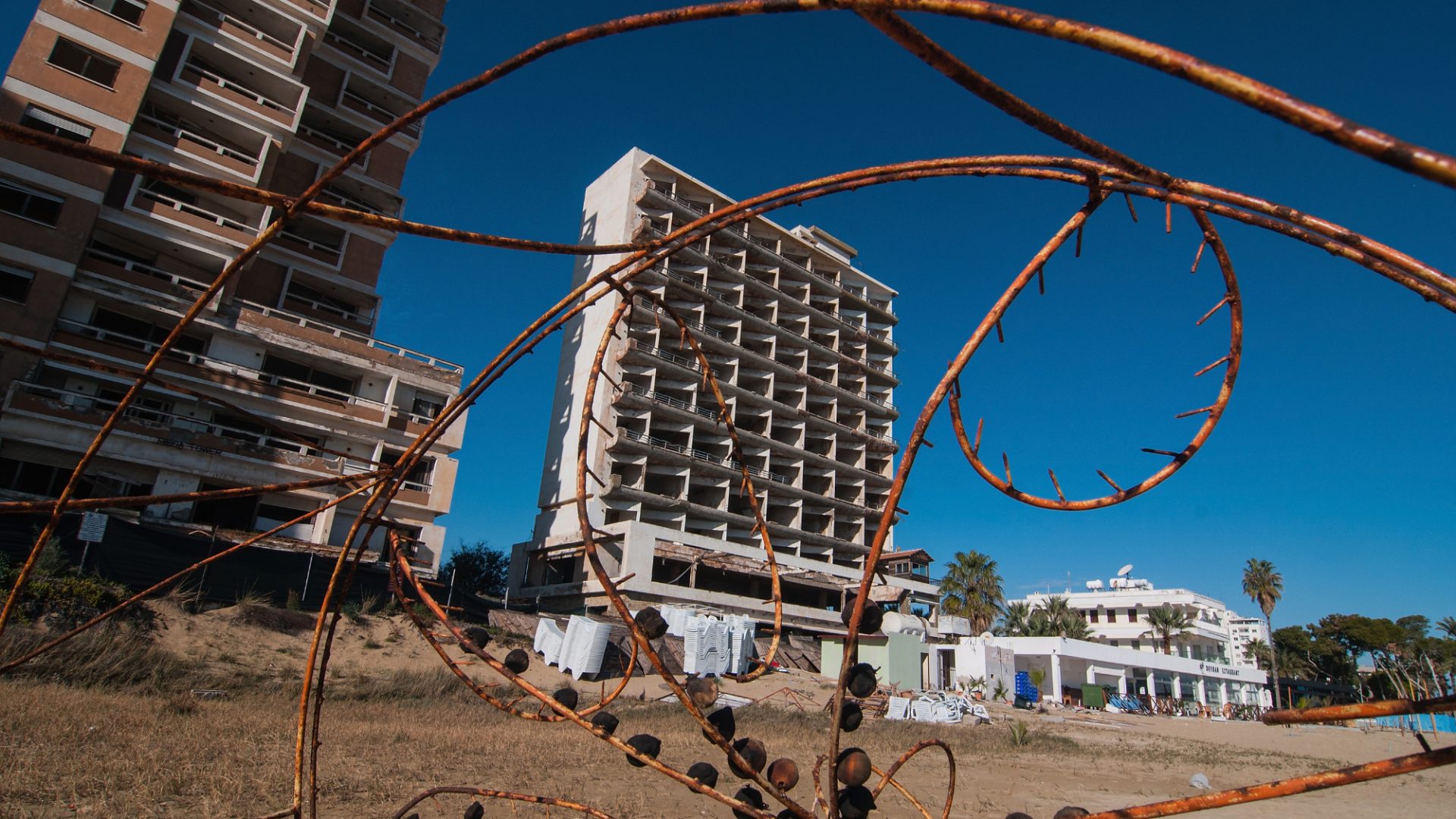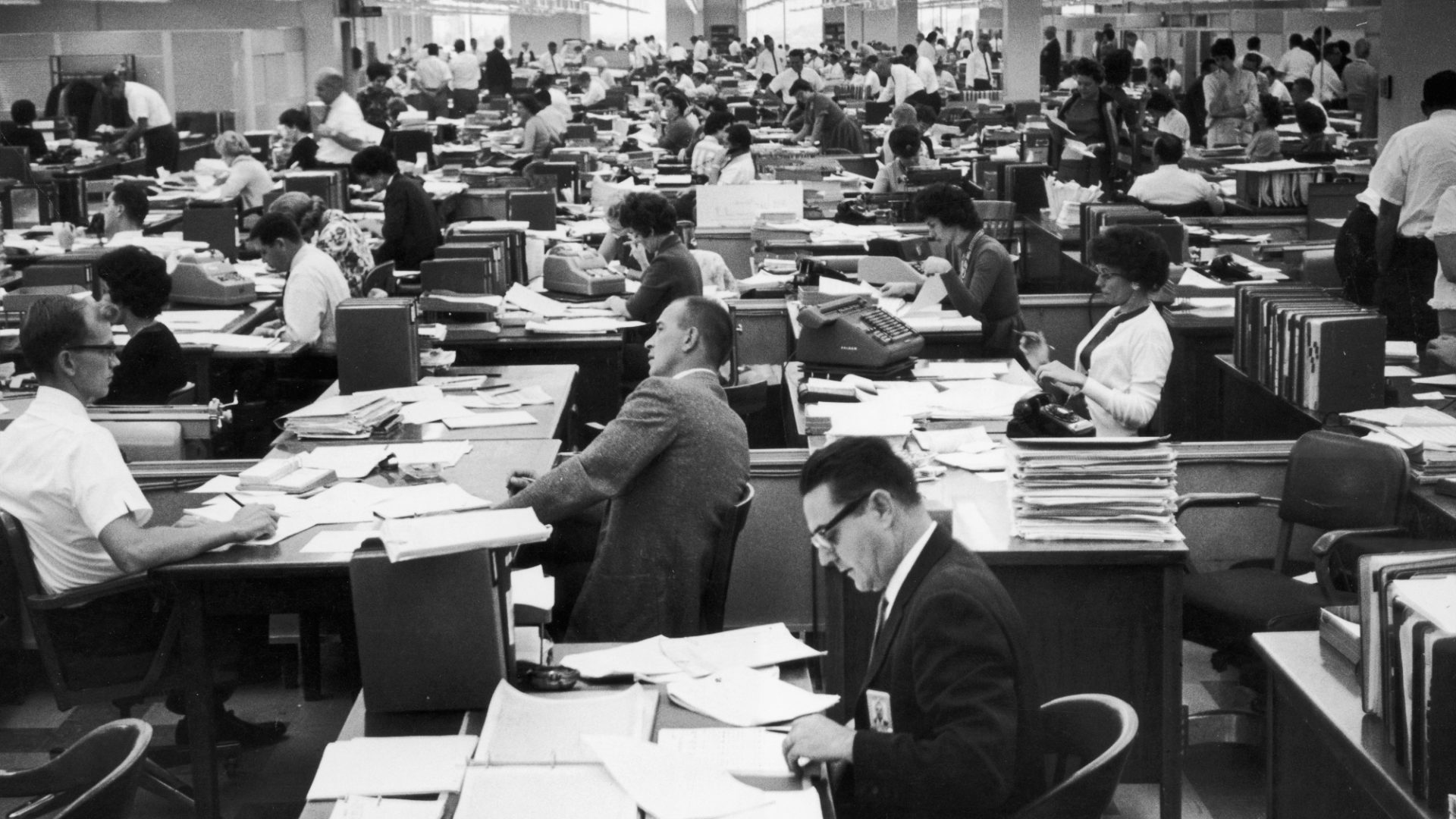Throughout the 1950s, a Cypriot Greek separatist group called EOKA fought British colonial authorities for the island’s independence, which was achieved in 1960. But political and ethnic instability and a decline in relations between Turkey and Greece led to the Turkish invasion of Cyprus in July 1974. The Cypriot resort of Varosha was abandoned by its inhabitants when Turkish forces invaded.
The “tourist entrance” can be found near Dr Fazıl Küçük Stadium, south of Famagusta’s old city walls. Turkish Cypriot police check your bag for drones, and you are directed down a strip of newly laid tarmac, which is already beginning to crack with the heat from above and the stubborn, well-rooted plants beneath.
Three-foot rope barriers flank both sides of the street, which gives the strange impression that you are touring a film set; your brain fumbles for any comparison other than a disaster movie. The next closest thing is Pripyat, the town where Chernobyl workers were living in 1986, but Varosha had already been fenced off for 12 years when that happened.
My dad and I, along with our guide, a kind and patient man called Suleyman, are among the first to be admitted to the ghost town, known in Greek as Varosha and in Turkish as Maraş.
For 47 years the Turkish military kept everyone else out. Images of the boundary fence circulated online: a bright red sign picturing a soldier bearing an automatic rifle, with the words “restricted area, no entry” in Turkish, and “forbidden zone” in English, French and German.
Next to that, tied to the wire, a handwritten note in Greek on a piece of paper. “I left my soul in there. Open up!”
Beyond the wire fence it looked as if the town had been abandoned in a hurry after a very localised earthquake. Facades peeled like sunburnt skin. A sign reading “mines” in Greek and English, with a helpful pictogram showing a blast and a one-legged figure with crutches. In the bowels of the internet, a photo circulated of the Toyota dealership on Leonidas Street with cars that looked as if they’d been in a sandstorm, their mustard colour barely showing, their tyres flat.
What sets the teeth on edge is witnessing the decaying body of the town after its soul has fled. Time has chewed the place to a sour cud. There is a common myth that concrete will last 1,000 years, but in reality most modern concrete buildings will last more like 50 or 100, which means that none of these buildings can be reused or reoccupied. They can only be condemned.
We turn left at the roundabout. Some enterprising Greek Cypriot has hopped over the little rope barrier that everywhere separates the road from the chaos – though there is nothing left to loot – and sprayed “EOKA” on the wall of a church, scrubbed clean but still visible.
Graffiti is starting to creep in all across Varosha in the six months since the promenade opened. On the wall of a Greek Cypriot bank, someone has written “Makarios”, the first Greek president of Cyprus. Others have simply listed their names on the inside walls of emptied-out buildings. There is almost no one else here. Compounding the eeriness, the changing of the guard is signalled by Für Elise, piping out through dozens of tannoys, as if this is the arena for an episode of Squid Game.
At the beach, there is a kiosk called Vitamin Bar selling coffee and ice cream. The waters are calm and blue as copper sulphate. Once, Sulli went diving here and found himself face to face with a turtle “the size of a Mini Cooper”.
I look south down the bay and take in the scale of dereliction. It’s one of the longest beaches in Europe, with abandoned multi-storey buildings as far as the eye can see.
Running parallel to the shore is the main street, John F Kennedy Avenue. In the 1950s, it had the feel of an up-and-coming resort, with the chrome bumpers of Morris Minors glinting along the roads and the villas painted like Neapolitan ice cream.
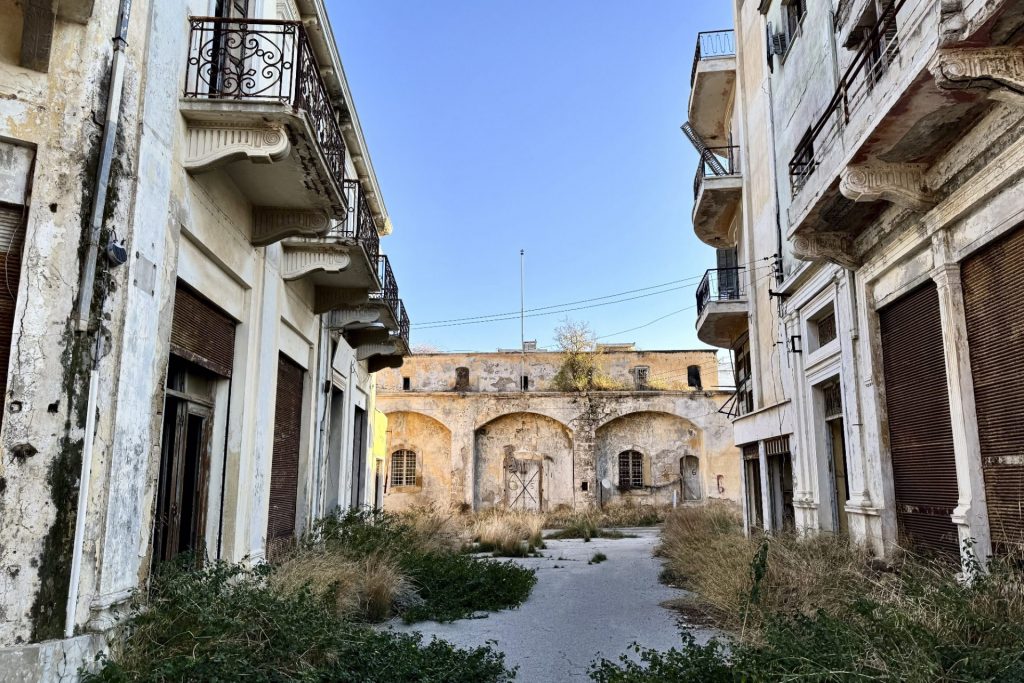
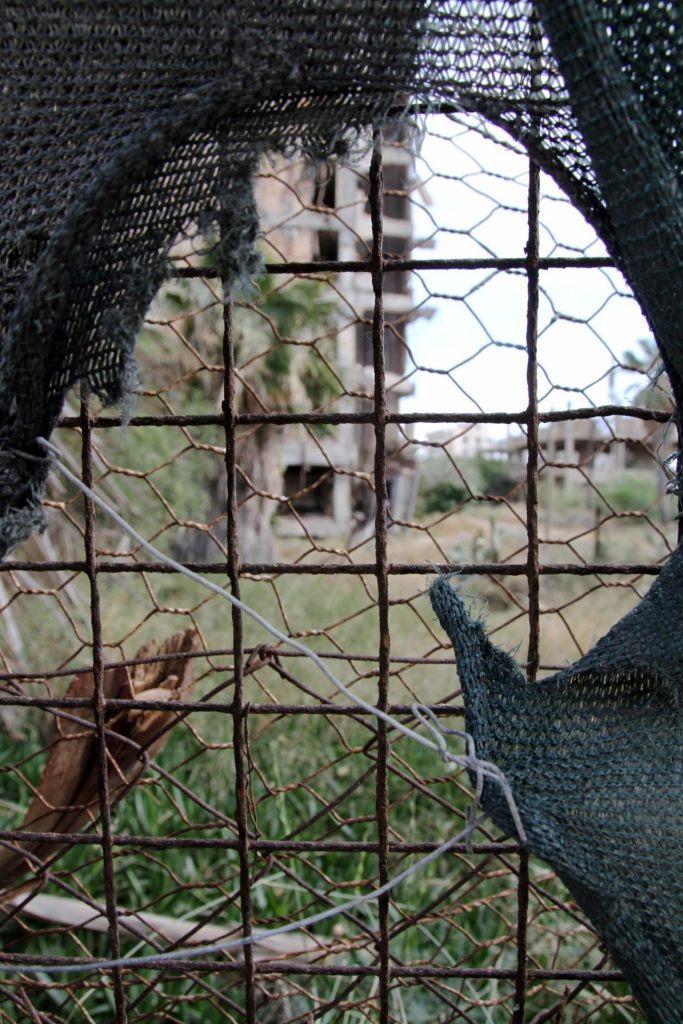
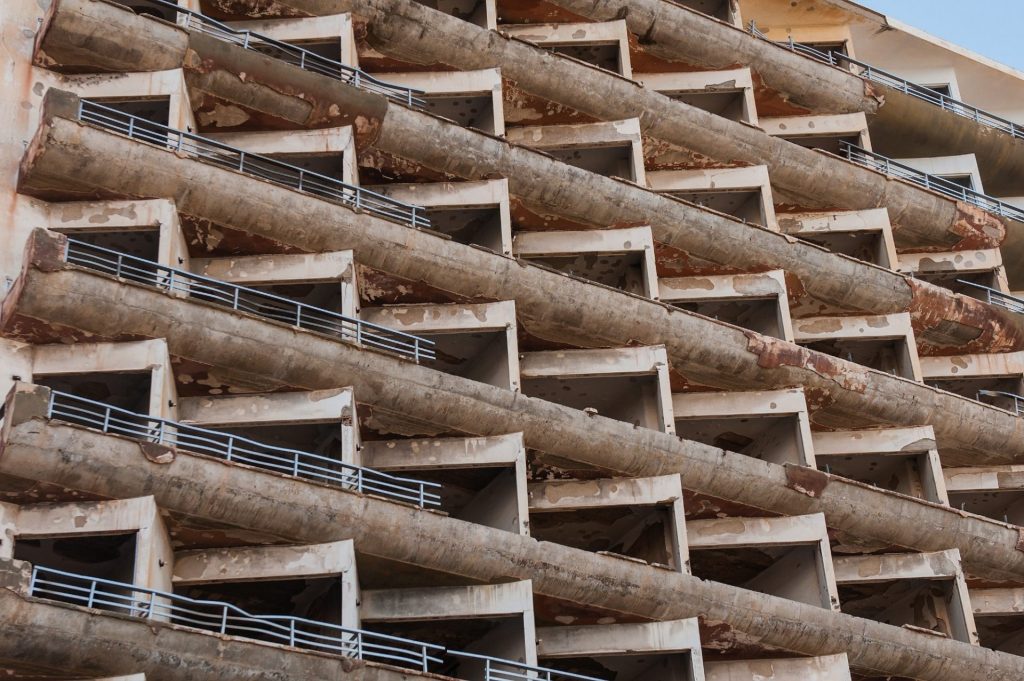
By 1974, the city had over 100 hotels. In the lobby of each, the guest books are filled in up to August 14. The Turkish army has since been billeted in two hotels; the rest are slowly being reclaimed by the earth.
When tourists first arrived, the locals had such plans for this beach. They built the tallest buildings on the island: the King George, the Grecian, the Florida, the Argolis. The city started to become popular with the jet-set. Paul Newman filmed Exodus here in the spring of 1960, while Richard Burton and Elizabeth Taylor stayed at the Argolis on their summer holidays. Brigitte Bardot was photographed in her bathing suit on the beach.
People would say it was the Las Vegas of the Mediterranean, or the Cyprus Riviera – it felt as if the city had captured something of the spirit of the age, and that anything was possible.
In April 1970 a Swedish couple named Björn and Agnetha invited their friends Benny and Frida along with them on their engagement trip to Famagusta – they had arranged with the travel agents Fritidsresor that they would get a free trip if they did a gig for the UN while they were there.
The men brought their guitars and they’d have singalongs on the beach in the evenings, or on the balcony of the Twiga Tower Hotel. They enjoyed their half-hour gig so much that they decided to form a band, which they called Festfolk. By the time they won the Eurovision Song Contest in 1974, they had rebranded as ABBA.
Just north of us up the beach, on the other side of a no-man’s-land of weeds and corrugated-iron barriers, is the Palm Beach hotel, sparkling blue and white, with brand-new plastic sun loungers, open for business a stone’s throw from the rubble, just out of the evening shadow of a neighbouring building pock-marked by bullet holes.
Set just back from the beach is the Blue Bungalow, once the home of the artist Pol Georgiou, who painted religious subjects as well as the life and history of the island.
His paintings are tall and thin: his minaret looms like a lighthouse and his priests seem trapped in pillars of colour, human totem poles. In his palette, he returns often to sky and beach, mixing sand in with the final coat.
From the road, you can glimpse some of the few treasures that remain through the window: a traditional blue and white plate, chipped but improbably still hanging on the wall; a blue-patterned border depicting lions and a figure in a red and white striped dress. Out of sight are murals, a modern icon, Byzantine churches, an armoured knight on horseback.
Some of the art went missing, but in total 41 paintings were exchanged through a bicommunal committee and now hang in museums.
As we contemplate what’s left, a young Iranian woman approaches. She is doing a PhD in tourism. She asks whether any of us had family here, aching to express sympathy to a human face, and we regretfully respond that we don’t.
“It’s so sad what happened to the Greek people,” she says. Then, brightening up: “I wanted to sneak in here for a long time, but I didn’t want to waste my parents’ money on my education if I got shot.” A mixed group, we smile noncommittally.
Walking up the main path, the Toyota dealership next to the UN 148 post is empty. Not even the chassis of cars remain.
Adverts are selling the brands that dominated the 70s: Kodak, Phillips, Coca-Cola, 7UP, Sharp. Shop signs read like a partially completed crossword: optica; uropa furs; Christy’ Stu; ol; nich; d. ou oun m. ou ian & co. Others are simply weathered. A big neon Hoover sign stands proud atop cracked walls and jagged broken windows. Pooh Corner House is empty. Titbit is empty. The metal security gate of New Smokey Joes is crumbling. The White Horse Inn doesn’t have a roof.
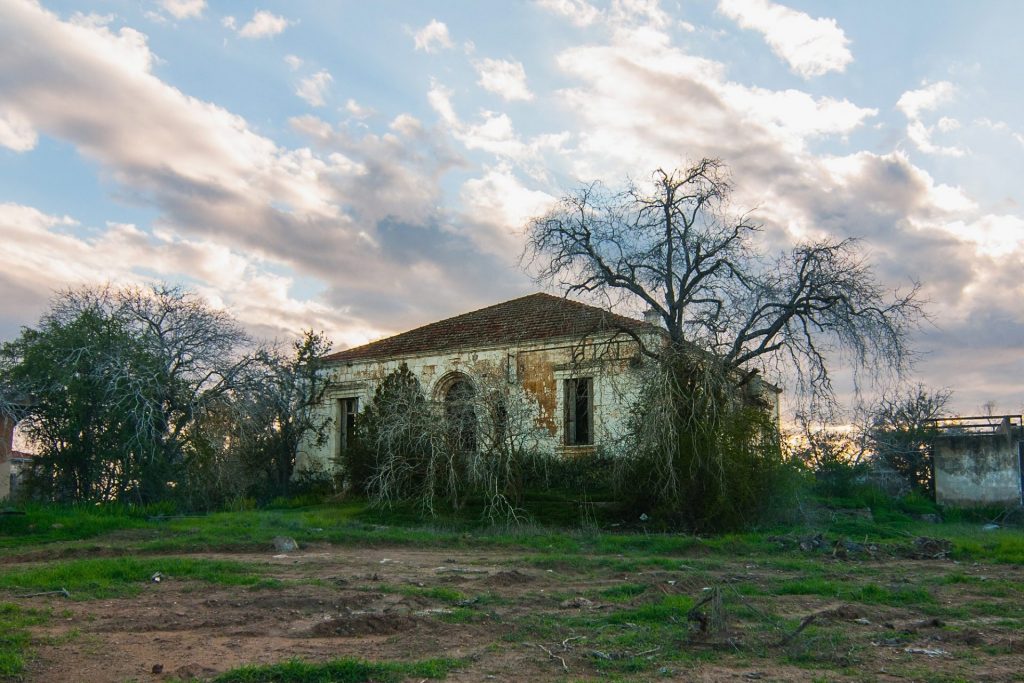
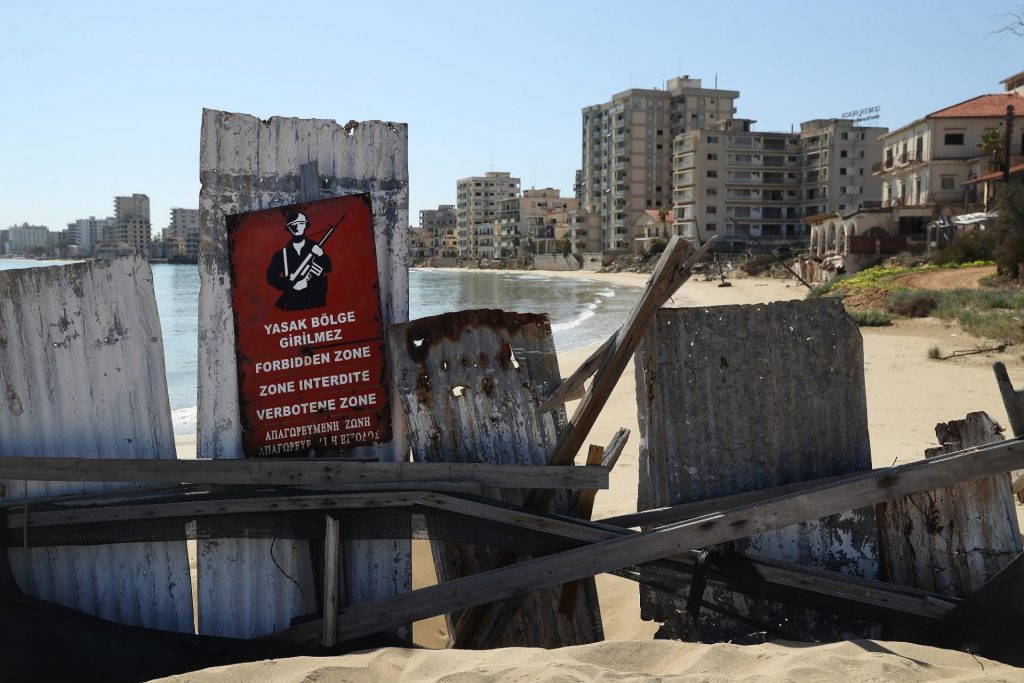
The thin, dry trees are taller than the lamp posts. Inside (The) Cu(r)ios(i)ty Shop, Vaspi, Bavvar, Kadir, Sarhan, Öner and Özkan have written their names, proud to have escaped the notice of the soldiers. Here is half a yellow post box, its belly emptied of letters.
Many businesses are heartbreaking in their specificity: Cleopatra Bazaar sells Egypt leatherwork and Cyprus pottery; the manager is M. Papachristodolou. Here is Pavlos Pierides’ business, CARNABY, a Cyprus lace shop selling handicrafts and souvenirs.
I see one or two dress shops, and at each I wonder where Catherine Cutliffe, the 39-year-old wife of a British sergeant, was shot in the back by EOKA killers while shopping with her daughter on October 3, 1958.
I know it was outside a dress shop on Hermes Street, off the tour path, but the street is impossible to locate without a pre-1974 map.
Among all this, there is a branch of Barclays that has a conspicuously pristine sign, its entrance guarded by soldiers. Its vault has been in legal limbo for five decades; periodically, officials come to check the vault’s contents are still there, then lock it again and leave.
The Turkish Cypriot guards work on 24-hour shifts. In that time they aren’t allowed to sleep or move from their post – they bring their rations with them. Some have been sitting at the same crossroads, with nothing happening, for 20 years like this.
On the way over, we had talked about the way people were displaced by the events of 1974. Sulli’s family had to leave everything behind in Paphos, fleeing to the north. After the checkpoints were opened in 2004, they noticed a car kept circling around their block. Eventually someone stopped them; the strangers were driving past their old house, over and over. Someone invited them in to look around. The hosts offered them lunch, and cooked kebabs for them. They ate together, the guests took two or three lemons from the tree, and then they left.
I have taken to calling the different parts of the island “north” and “south”, the most neutral terms that the situation affords, but in conversation people will often refer to the “Greek Cypriot side” and the “Turkish Cypriot side”, with all the opposition that implies. As we crossed over into the north, the time was officially still the same as in the south, but my phone stubbornly updated itself to an hour later, mainland Turkish time (and sometimes, near British sovereign territory, it is suddenly two hours earlier).
Across the landscape north of the crossing were concrete husks, each hoarding a shadow. The trails of barbed wire long and rusted. I thought to myself, the olive trees are the same here, and then felt sad and absurd to have had the thought.
Demarcation line; Green Line; buffer zone. To call it a border is to imply that there are two different countries on either side, which many in the south would find offensive. By law (de jure) it also isn’t true; though in practice (de facto) the two sides function as states independently of one another. The latter judgement is probably painful and affronting for many progressive Greek and Turkish Cypriots who have longed for a unification of the island, but the world spins on as it is without our wishing.
Cyprus could once boast that it was “an ethnographical fruit cake in which the Greek and Turkish currants were mixed up in every town and village and often in every street”. By the time the Turkish invasion was finished, it looked more like something grimly curdled. Less than 60% of the island comprised the Republic, with about 36% occupied by the Turkish military, about 2% no-man’s-land separating the two, and 3% still given over to the presence of a British military that had given up all pretence of being a guarantor of peace.
I look out one last time at Famagusta Bay. It is known in Greek as Kólpos Ammohostoú. Ammohostos means “buried in the sand”. Kólpos is a beautiful word in Greek, an ancient word. It means “bay”, but it is also a hollow between the waves, a bosom, the chamber of a heart. A womb.
True to the bay’s name, there is something buried in the sand here. It crept in when the silence fell. On rare nights, when the moon is full, little furrows and avalanches appear all across the abandoned beach. Then, a dark little head peers out, resting for a second before fighting its way out of the collapsing sand. Its first taste of this world is to be buried alive. The little animal, no bigger than a fist, flaps over the sand on its belly, its progress slow, painfully vulnerable in the open air.
Others unbury themselves, 20 or more. Each green turtle must drag itself across a desert on its belly, dive-bombed by gulls, not even knowing that there is such a thing as the sea, and that it was made for it, but dragging itself along with a fixed idea that the struggle has a purpose, despite all evidence to the contrary. Eventually its body will glide noiselessly along at last, touching nothing, not even breathing, only gliding in peace.
Alex Christofi is the author of Cypria: A Journey to the Heart of the Mediterranean, published by Bloomsbury Continuum

